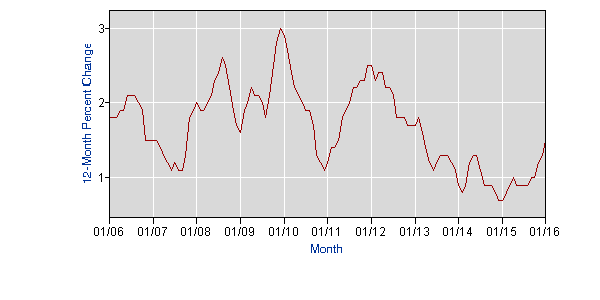February 27, 2016
The job killers (proponents of Fed rate hikes) seized on some modest upticks in the January inflation data to argue that the economy is near capacity and the Fed should be pushing up interest rates. After all, the core (excluding food and energy) consumer price index (CPI) rose by 2.2 percent over the last year, somewhat over the Fed’s 2.0 percent target. That’s pretty scary stuff.
I’ll make a few quick points here. First, the Fed officially targets the core personal consumption expenditure deflator. That index has risen by just 1.7 percent over the last twelve months, still below the Fed’s target.
Second, the Fed’s target is explicitly an average rate of inflation, not a ceiling. Many of us think that the 2.0 percent target is arbitrary and unreasonably low, but even if we accept this level, the inflation rate has a long way to go upward before the Fed will have even hit this target. We could have 4 years of 3.0 percent inflation and still be pretty much on target over the prior decade.
The third point is that the modest uptick in the inflation rate shown in the CPI is largely coming from rising rents. Here is the index the Bureau of Labor Statistics constructs for a core index that excludes shelter (mostly rent).

Source: Bureau of Labor Statistics.
There is a very small uptick in this index also, but only to 1.5 percent inflation over the last year. (There was a much larger uptick at the start of 2011.) We are still well below the Fed’s 2.0 percent inflation target if we pull out rent.
This matters, because if higher inflation is being driven by rising rents, it is not clear that higher interest rates are the right tool to bring prices down. Every Econ 101 textbook tells us about supply and demand. The main factor pushing up rents is more demand for the limited supply of housing. The best way to address this situation is to construct more housing.
But housing is perhaps the most interest sensitive component of demand. If we raise interest rates, then builders are likely to put up fewer new units. This will create more pressure on the housing stock and push rents up further.
Yes, the fuller picture is more complicated. Zoning restrictions often prevent housing from being built and there are many issues about what type of housing gets built. But as a general rule, more housing means lower rents, and if the Fed’s interest rate hikes lead to less construction, they will likely lead to a higher rate of rental inflation, the opposite of its stated intention.
The moral of the story is that the Fed should keep its fingers off the trigger. There is no reason for concern about inflation in the economy in general and in the one major sector where it is somewhat of a problem, higher interest rates will make the situation worse.







Comments